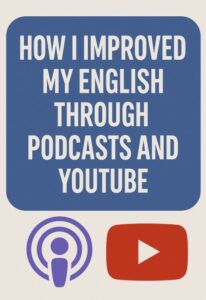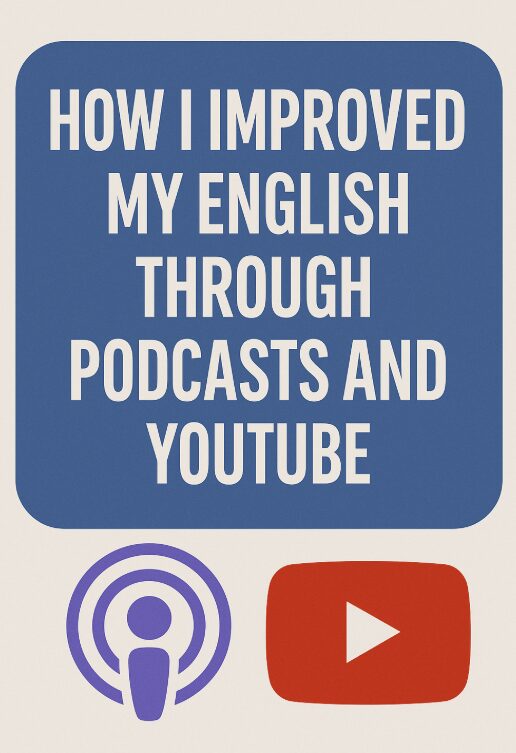Learning English has always been one of my biggest goals. I wasn’t trying to become an English teacher or ace a test—I just wanted to communicate better, understand global content, and feel confident expressing myself. I didn’t go to an expensive language academy or study abroad. Instead, I built my English fluency through one of the most accessible methods out there: podcasts and YouTube.
In this post, I’ll share how I made the most of these platforms, which specific podcasts and channels helped me the most, and how you can use them to upgrade your own English naturally and enjoyably.

Why Podcasts and YouTube Worked Better Than Textbooks
At first, I thought the only way to learn English was by memorizing grammar rules and vocabulary lists. But I often forgot what I studied and had no idea how to apply it in real life. Podcasts and YouTube changed everything.
Here’s why they helped so much:
Real conversations: I heard how native speakers actually talk—not just textbook examples.
Passive learning: I could listen while walking, commuting, or doing chores.
Cultural exposure: I understood not only the language but also the humor, context, and tone.
No pressure: I learned at my own pace, rewinding as often as I needed.
The key is not just watching or listening, but doing it consistently—and with a bit of strategy.
My Favorite English Podcasts for Daily Listening
If you want to improve your English listening skills and vocabulary, podcasts are one of the best tools. I started with slow, simple shows and gradually moved on to natural-speed conversations.
Here are a few that made a big impact on me:
The English We Speak: A short, fun podcast by the BBC that teaches British idioms and expressions in just 3 minutes.
All Ears English: American hosts talk about culture, conversation tips, and confidence-building strategies. It’s friendly and easy to follow.
The Daily: From the New York Times, it covers current events and is great for advanced learners who want to expand vocabulary in real-world contexts.
Luke’s English Podcast: Hosted by a British teacher with humor and thoughtful explanations, especially helpful for intermediate learners.
ESL Pod: Focused on clear pronunciation and repetition, this one helped me understand American-style English in daily life situations.
I listened every morning while getting ready or commuting. Even just 15–20 minutes a day adds up fast.
YouTube Channels That Transformed My Speaking and Pronunciation
Unlike podcasts, YouTube allowed me to see facial expressions, lip movements, and gestures—all important for improving speaking and pronunciation.
These are the channels I used the most:
Speak English with Mr. Duncan: One of the original English YouTubers, he teaches vocabulary and grammar in a fun, visual way.
English Addict: Also by Mr. Duncan, but more conversation-focused and streamed live with real questions.
English with Lucy: A beautifully produced British English channel with lessons on pronunciation, phrasal verbs, and native expressions.
Speak English with Vanessa: She explains difficult topics naturally and teaches how to sound more fluent.
Rachel’s English: If you’re focused on American accent and pronunciation, Rachel’s videos on mouth shape and rhythm are gold.
I created playlists for each channel and rewatched the same videos to reinforce what I learned.
Combining Listening With Speaking Practice
Just watching videos and listening to podcasts wasn’t enough. I knew I needed to speak to improve fluency. But I didn’t always have a partner. Here’s what helped:
Shadowing: I would repeat after YouTubers or podcasters, mimicking tone and rhythm.
Recording myself: Using my phone, I recorded short explanations or summaries.
Reading aloud: I’d read English articles out loud to practice fluency.
Commenting in English: I left comments under videos or podcast episodes, which also helped me practice writing.
Doing this daily, even just for 5 minutes, helped me gain confidence fast.
How I Discovered New Content and Avoided Burnout
To avoid getting bored or stuck at one level, I diversified my sources:
I followed Instagram pages that shared clips from English interviews.
I watched reaction videos and vlogs to learn casual expressions.
I listened to TED Talks when I wanted more formal or academic vocabulary.
I searched phrases like “British vs. American English” or “How to sound fluent in English” on YouTube and discovered even more creators.
The secret was to keep things fresh and choose topics I genuinely enjoyed—like psychology, travel, or self-improvement.
Start With What Interests You and Stay Consistent
If you’re trying to improve your English without expensive lessons or moving abroad, podcasts and YouTube can take you very far. You don’t need to understand every word—you just need to show up every day.
Find content that excites you. Start with a podcast that fits your level or a YouTube channel that matches your goals, and build a routine around it.
Small steps daily make big changes over time. That’s how I went from shy listener to confident speaker—and you can too.
